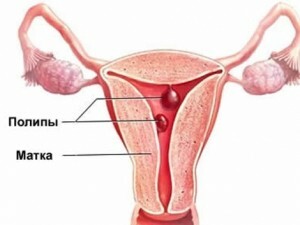Hyperplastic processes of the uterine mucosa start under the influence of many factors. As a result, approximately 25% of diagnoses cause a polyp to form on it. They often appear on the threshold of menopause or in women who have crossed it, but they can also disturb in the reproductive period. Polyp of the endometrium, the code for μb 10 No. 84.0, is considered as a benign neoplasm of the uterus body.
What this term includes
 Polyp is formed from the components of the sprouting part of the endometrium, which excludes the chance of elimination of the tumor. It has the form of an elevation on the stem, it can consist of different cells, which determines its appearance:
Polyp is formed from the components of the sprouting part of the endometrium, which excludes the chance of elimination of the tumor. It has the form of an elevation on the stem, it can consist of different cells, which determines its appearance:
- Iron. Appears more often in the reproductive period, because its development is dependent on the nuances of menstrual cycle disorders. These polyps consist mainly of glandular tissue. They are light pink or gray with a vascular pattern, located on the bottom or in the corners of the uterus;
- Fibrous. It is formed less often than the previous species, consists of a connecting material. These formations have the shape of an oval, a pink or yellowish color, an even shell and a wide base area. Most grow up in solitude;
- Iron-fibrous. It represents a mix of two tissues, in which the connective predominates. The color is pale gray or pink, the membrane with markedly enlarged sugars;
- Adenomatous. It is initially formed from glands, but differs by rapid growth and because of the danger of becoming a malignant tumor. They are more often found in menopause. Adenomatous neoplasms have a cyanotic or gray color, their configuration is uneven. These are the most dangerous tumors, therefore this type of polyps of the endometrium has a special code of μB 10 - under № D 28.
Despite the fact that according to the classification of the neoplasm it is part of the hyperplastic process, before the menopause and long before it, they can occur and with the usually developing mucosa. In postmenopausal polyps appear against the background of atrophic changes in the endometrium.
What causes the appearance of polyps
Polyps of the endometrium appear on the background of a hormonal failure with an excess of estrogen concentration. The substance stimulates the growth of tissues due to the increased division of their cells, and also provokes a disorder of menstrual function. Replacement of the functional layer of the mucosa occurs with various kinds of problems, which causes changes in some of its segments. Polyps are localized there."Help" is capable of:
- Abortions performed with organ damage;
- Inflammation processes in the endometrium;
- Fibromyoma of the uterus;
- Internal endometriosis;
- Diabetes mellitus;Benign neoplasms on the ovaries( cysts, polyps, tumors);
- Disturbance of adrenal function;
- Obesity;
- Incorrect use of hormonal drugs.
An excess of estrogens is usually supplemented with progesterone insufficiency, often anovulation. Hormonal disorder is total, which also affects the work of other organs. It was noted that women with a diagnosis of "endometrial polyps" often have chronic cholecystitis, dysfunction of the gallbladder.

As the polyp gives information about its presence
 Since the processes causing hyperplastic changes in the mucosa have a noticeable effect on the body, the 10th polyp endometrial mdb classifies according to the following symptomatology:
Since the processes causing hyperplastic changes in the mucosa have a noticeable effect on the body, the 10th polyp endometrial mdb classifies according to the following symptomatology:
- Increased volume of menstrual flow;
- Irregularity of arrival of critical days;
- Bleeding on other days of the cycle;
- Blood-borne secretions caused by contact;
- Painful sensations in the lower abdomen, if the neoplasm is not single or noticeable.
In adenomatous polyps, women also have complaints about:
- Headaches;
- An unjustified weight gain;
- Somnologic disorders;
- The appearance of hair where there was none before;
- Rapid fatigue, irritability.
 We recommend to read an article about the monthly for a polyp. You will learn about the causes of its appearance, the impact of education on the nature of menstruation and cycle, the methods of treatment of the disease.
We recommend to read an article about the monthly for a polyp. You will learn about the causes of its appearance, the impact of education on the nature of menstruation and cycle, the methods of treatment of the disease.
Consequences of the development of the endometrial polyps
The polyp endometrial microbe included in the sub-heading "polyps of the uterus body".The consequences of its presence on the mucous surface of the organ can prevent many of its tasks and the reproductive system in general. Among the most serious:
-
 Anemia. Emergence of the disease lead to a large volume of blood loss, which the body can not compensate. There is a deficiency of hemoglobin, a lack of oxygen in the tissues, as a consequence, a decline in strength, constant drowsiness, fainting;Infertility and miscarriage. Caused by the violation of the cycle due to the formation of an imbalance of female hormones prevents the maturation of the germ cell, conception does not occur. If ovulation has occurred, and then pregnancy has followed, the wrongly formed envelope of the uterus is not able to take a fetal egg;
Anemia. Emergence of the disease lead to a large volume of blood loss, which the body can not compensate. There is a deficiency of hemoglobin, a lack of oxygen in the tissues, as a consequence, a decline in strength, constant drowsiness, fainting;Infertility and miscarriage. Caused by the violation of the cycle due to the formation of an imbalance of female hormones prevents the maturation of the germ cell, conception does not occur. If ovulation has occurred, and then pregnancy has followed, the wrongly formed envelope of the uterus is not able to take a fetal egg; - Pregnancy problems. The existence of a polyp does not preclude conception by 100%, but seriously complicates the development of a new condition. Due to the inferiority of the endometrium, there is a constant threat of abortion, bleeding, placental abruption. The fetus may not receive mandatory for the development of substances due to insufficient blood supply to the uterus;
- Transformation of normal cells into atypical cells. Cancer of the uterus is much more dangerous and more difficult to eliminate the disease;
- The death of a polyp. When necrotic necrosis is triggered in his area, it occurs with severe bleeding and pain. Here, urgent help is needed, consisting in the removal of the neoplasm or the entire organ.

If scraping and moxibustion are performed qualitatively, the return of ailment to a woman is not threatened.
